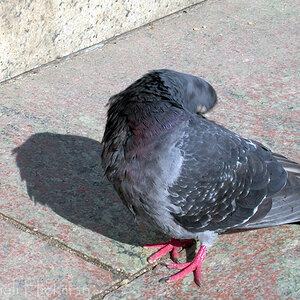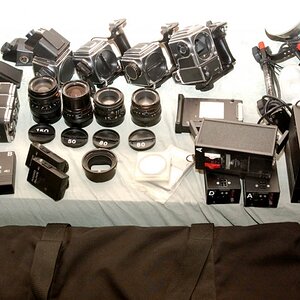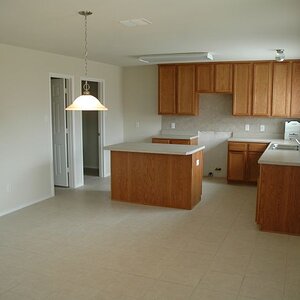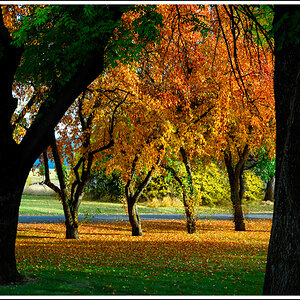Bifurcator
TPF Noob!
- Joined
- Jun 1, 2008
- Messages
- 3,312
- Reaction score
- 1
- Location
- Japan
- Can others edit my Photos
- Photos OK to edit
Hi, and thanks for reading my rant.
I was mainly looking for advice on lenses.
I already purchased a Canon EF 28-90mm F/4-5.6 III, but was looking for a decent and inexpensive telephoto lens (who doesn't?). I had my eye on the Tamron 70-300mm F/4-5.6 lens, but have read many reviews saying that it is a rather 'soft' lens, so maybe I should just go with a Canon lens?
I was also looking for a decent wide angle lens and a 50mm prime, any suggestions would be awesome. Are there any other dedicated lenses that you would recommend? I was also looking at getting an external flash to augment the one that is built into the XT, as well as a remote shutter release cable. Thanks in advance!
Others can answer more about various lenses. I have been going by a rule of thumb I formulated about 30 or more years back. Which is basically just "always buy maker glass".
One way you can save money without sacrificing quality if you're careful is to make use of high quality aspherical, achromatic, and apochromatic attachments in the form of CloseUp Filters (adds macro abilities with no downsides other than having to screw and unscrew them), teleconverters (on the end of the lens can increase focal distance between 1.2 and 2.0 times without too much degradation - usually in the middle of the aperture range almost none at all), and wide converters (also added to the end of a lens and if AC or APO have no detectable adverse affects on image quality - they're great up until about 0.6x).
There are also extension tubes and doublers that attache between the body and the back of the lens but you're exposing the sensor to dust with every use. Extension tubes might produce a tiny tad better image quality (I doubt it) than a good close-up lens but to get a set that allows the electrical functions of the lens to work you're talking about several times the cost of a close-up lens.
The main gotcha with end-lens attachments is that many lenses will now be subject to "creep" if the attachment is very heavy. Creep is where a zoom lens will zoom in or out under it's own weight when pointed upward or downward. It's usually not a problem but it can be - especially on a pod pointed straight down.
When you're shopping for lenses test reports like at http://www.photozone.de/Reviews/45-canon-eos-aps-c and http://www.cameralabs.com/reviews/digital_camera_and_lens_reviews.shtml will tell the most by far. User reports and ratings are subjective and just about meaningless. If the review site doesn't include a set of uniform tests (like http://www.lensplay.com/lenses/lens_top_ten.php or http://www.lensplay.com/lenses/lens_list.php ) then it's not actually useful and is just tracking popularity and trends.
One rule that seems to have held over the years is that prime lenses are generally sharper than zooms. Zooms are a compromise between quality and convenience.
A dedicated flash is handy but I think researching the usage styles and results of a strobe head and a flash unit is pretty important if your operating from a position of limited funds. You may find that for the same money and for what you want to do with it that one or the other are much more suitable. Check out sites like http://prophotolife.com/video-library/ (start at the bottom of the page) where all kinds of off camera lighting are considered to know more before dishing out the cash for one kind or another.
Others can add more as the thread goes on.





![[No title]](/data/xfmg/thumbnail/40/40310-01bec1b9b7918522bf21a09cf75c5266.jpg?1619739414)
![[No title]](/data/xfmg/thumbnail/35/35931-5e10675f3f7d827bc7ae4689f16bda8a.jpg?1619737234)

![[No title]](/data/xfmg/thumbnail/39/39443-45e1b162b6c7c1d8ebbc8faf5623b705.jpg?1619739034)
![[No title]](/data/xfmg/thumbnail/35/35929-8650428697cfb142a7b9a4e8ef731178.jpg?1619737232)
![[No title]](/data/xfmg/thumbnail/39/39439-d0a6beaaf39993860b74ccbd81fdd122.jpg?1619739032)

![[No title]](/data/xfmg/thumbnail/40/40309-c759bfd4ae7c079632e7402d21d332f1.jpg?1619739414)

![[No title]](/data/xfmg/thumbnail/41/41492-467958db3420bceb7ab410a12dcc681f.jpg?1619739819)
